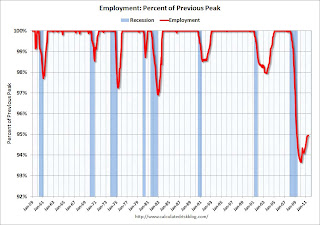by Calculated Risk on 8/02/2011 12:55:00 PM
Tuesday, August 02, 2011
Recession Measures
By request, here are four key indicators used by the NBER for business cycle dating: GDP, Employment, Industrial production and real personal income less transfer payments.
Note: The following graphs are all constructed as a percent of the peak in each indicator. This shows when the indicator has bottomed - and when the indicator has returned to the level of the previous peak. If the indicator is at a new peak, the value is 100%.
These graphs show that no major indicator has returned to the pre-recession levels - and most are still way below the pre-recession peaks.
 Click on graph for larger image in graph gallery.
Click on graph for larger image in graph gallery.
This graph is for real GDP through Q2 2011 and shows real GDP is still 0.4% below the previous pre-recession peak.
At the worst point, real GDP was off 5.1% from the 2007 peak.
And real GDP has performed better than other indicators ...
 This graph shows real personal income less transfer payments as a percent of the previous peak.
This graph shows real personal income less transfer payments as a percent of the previous peak.
With the revisions, this measure was off almost 11% at the trough - a significant downward revision and shows the recession was much worse than originally thought.
Real personal income less transfer payments is still 5.1% below the previous peak.
It will be some time before this indicator returns to pre-recession levels.
 This graph is for industrial production through June.
This graph is for industrial production through June.
Industrial production had been one of the stronger performing sectors because of inventory restocking and some growth in exports.
However industrial production is still 7.6% below the pre-recession peak, and it will probably be some time before industrial production returns to pre-recession levels.
 The final graph is for employment. This is similar to the graph I post every month comparing percent payroll jobs lost in several recessions.
The final graph is for employment. This is similar to the graph I post every month comparing percent payroll jobs lost in several recessions.
On the timing of the trough of the recession, GDP and industrial production would suggest the end of Q2 2009 (and June 2009). The other two indicators would suggest later troughs.
And of course the recovery in all indicators has been very sluggish compared to recent recessions.


